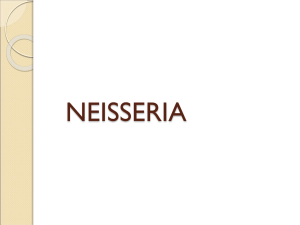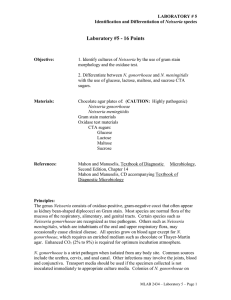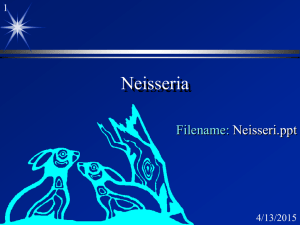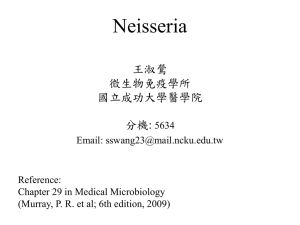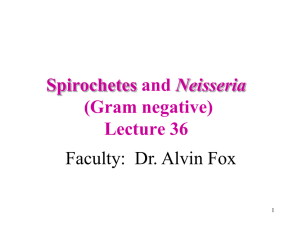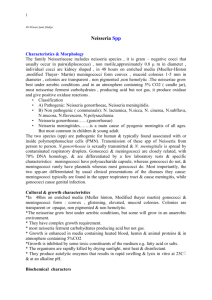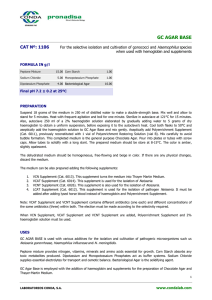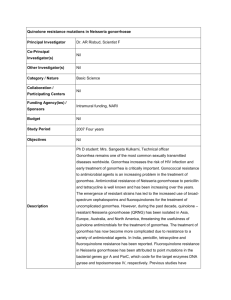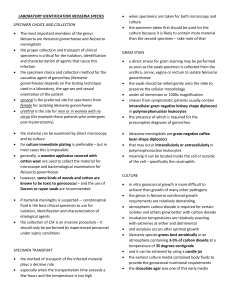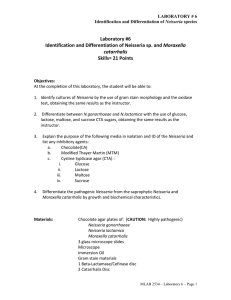Gram Negative Bacteria
advertisement
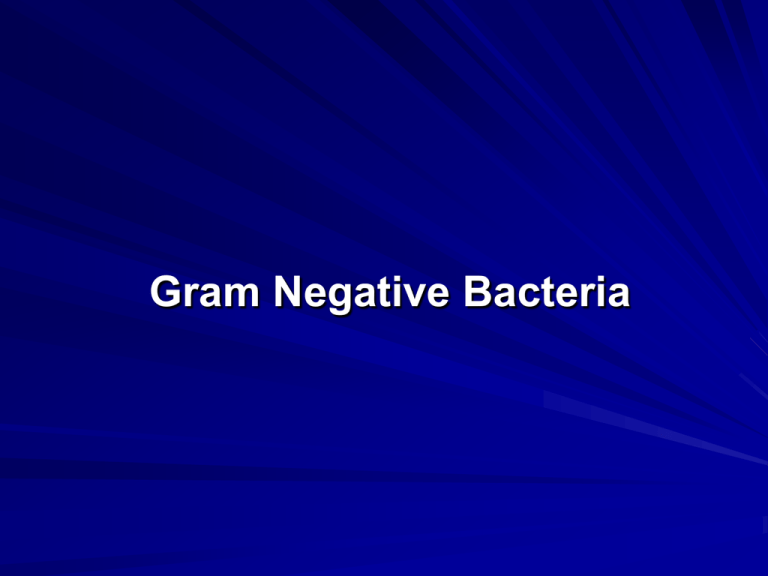
Gram Negative Bacteria NEISSERIA General Characteristics: Neisseria Species Aerobic, gram-negative diplococci Nonmotile Oxidase positive Catalase positive Fastidious, capnophilic Neisseria Species Habitat – Upper respiratory tract – Genitourinary tract – Alimentary(Digestive) tract Primary pathogens: – N. meningitidis – N. gonorrhoeae Neisseria meningitidis Pathogenesis: Humans are the only natural hosts The organisms are transmitted by airborne droplets Colonize the nasopharynx and become transient flora of the upper respiratory tract. From the nasopharynx, the organism can enter the bloodstream and spread to meninges or cause meningococcemia. High-risk groups are: 1) Infants aged 6 months to 2 years 2) Army recruits. N. meningitidis is classified into serogroups based on different capsular polysaccharides, which are antigenic (stimulate a human antibody response). There are 9 serotypes of meningococcus (designated A, B, C, D, X, Y, Z, W135, and 29E). Meningitis is caused by groups A, B, and C. It has three important virulence factors: 1. Polysaccharide capsule. It is antiphagocytic in nature. 2. Endotoxin. It induces septic shock by causing release of cytokines. 3. IgA protease. It cleaves the IgA antibodies present in respiratory mucosa Clinical Findings: 1. Meningitis 2. Meningococcemia 1.Meningitis. The symptoms are fever, headache, stiff neck, and an increased level of Neutrophils in spinal fluid. 2.Meningococcemia. It occurs due to multiplication of bacteria in the blood stream. The severe form of it is life-threatening Waterhouse-Friderichsen syndrome. It is the septic shock induced by meningococcus Also called Fulminant meningococcemia. Feature include high fever, shock, widespread purpura, disseminated intravascular coagulation, thrombocytopenia, and adrenal insufficiency due to bilateral adrenal hemorrhages. Neck rigidity Laboratory Diagnosis: A. Specimens include. 1. Blood for culture and smears 2. Spinal fluid for smear, culture, chemical analysis. B. Blood smears on gram staining show gram negative bean shaped diplococci. C. Culture. The organism grows best on chocolate agar incubated at 37°C in a 5% CO2 atmosphere. Colonies are transparent or opaque. D. Oxidase test. Positive E. Maltose fermentation. The difference between N. meningitidis and N. gonorrhoeae is made on the basis of maltose fermentation. Meningococci ferment maltose, whereas gonococci do not. F. Latex agglutination test, which detects capsular polysaccharide in the spinal fluid. The classic medium for culturing Neisseria is called the Thayer-Martin VCN media. This is chocolate agar with antibiotics, which are included to kill competing bacteria. V stands for vancomycin, which kills grampositive organisms. C stands for colistin (polymyxin) which kills all gram-negative organisms (except Neisseria). N stands for nystatin, which eliminates fungi. Prevention: Chemoprophylaxis and immunization both used for prevention. Rifampin or ciprofloxacin used for prophylaxis in people who had close contact with the patient There are two forms of the meningococcal vaccine, each contains the capsular polysaccharide of groups A, C, Y, and W-135 as antigens (Tetravalent vaccine) 1. Unconjugated 2. Conjugated Neisseria gonorrhoeae: (Gonococcus). Non motile. Humans are only reservoir, not part of normal flora Causes disease only in humans. Killed by drying that’s why transmitted sexually. Pathogencity: The virulence factors are. 1. Pili. Most important virulence factors. Piliated gonococci are usually virulent, whereas non piliated strains are avirulent. 2. Two virulence factors in the cell wall a. Lipooligosaccharride (LOS) (a modified form of endotoxin). Endotoxin of gonococci is weaker than that of meningococci. b. Outer membrane proteins.(OMP). OMP cause attachment of bacteria to epithelial cells of the urethra, rectum, cervix, pharynx, or conjunctiva, like pilli. 3. IgA protease. The main host defenses against gonococci are antibodies (IgA and IgG), complement, and neutrophils. IgA protease degrades one of these antibodies. Virulence Factors PILLI Clinical Findings: Transmitted sexually both in males and females. Cause pyogenic infections. Females are usually asymptomatic. N. gonorrhea causes following infections. 1. Genitourinary tract infections ( Gonorrhea) 2. Disseminated infection via spread through blood stream. 3. Rectal infections. 4. Pharyngitis 5. Ophthalmia neonatorum 1. Genitourinary tract infections : Gonorrhea in men has features of urethritis accompanied by dysuria and a purulent discharge. Epididymitis can occur. In women, infection is initially in the endocervix (cervicitis), causing a purulent vaginal discharge and intermenstrual bleeding. The most frequent complication is ascending infection to the uterine tubes (salpingitis) which can lead to sterility or ectopic pregnancy 2. Disseminated gonococcal infection(DGI): Commonly manifest as arthritis, synovitis, or skin pustules. Disseminated infection is the most common cause of septic arthritis in sexually active adults. 3.Rectal infections: Prevalent in male homosexuals, are characterized by constipation, painful defecation, and purulent discharge. 4.Pharyngitis is contracted by oral-genital contact. The condition may mimic a mild viral or a streptococcal sore throat. 5.Ophthalmia neonatorum is an infection of the conjunctiva acquired by a newborn during passage through the birth canal of an infected mother . If untreated, acute conjunctivitis may lead to blindness. Lab diagnosis: 1.In the male, the finding of numerous neutrophils containing gram negative diplococci in a smear of urethral exudate provides a diagnosis of gonococcal infection. 2.In the female a positive culture is also needed. 3.Culture: N. gonorrhoeae grows best under aerobic conditions, and most strains require CO2 also. Gonococci are very sensitive to heating or drying. Cultures must be plated rapidly. N. gonorrhoeae grows rapidly producing small, raised, grey or translucent colonies after overnight incubation. 4. Oxidase test. Positive. Laboratory Diagnosis: Neisseria gonorrhoeae Media Selection Chocolate agar – Subject to overgrowth of normal flora Thayer-Martin agar is chocolate agar with vancomycin, colistin, and nystatin MTM contains the above plus trimethoprin Specimen MUST be plated on warmed media ASAP Incubation Inoculated culture media must be incubated at 350 C in 3% to 5% CO2 or candle jar Candle jar must use white wax candles Laboratory Diagnosis: Neisseria gonorrhoeae Colony morphology on modified Thayer-Martin (MTM) agar – Small, beige- gray – Translucent, smooth Fresh growth must be used for testing, because N. gonorrhoeae produces autolytic enzymes Laboratory Diagnosis: Neisseria gonorrhoeae – Oxidase Test Test on filter paper or directly on plate Oxidase reagent =Dimethyl or tetramethyl oxidase reagent Violet-purple color indicates a positive result Laboratory Diagnosis: Neisseria gonorrhoeae Carbohydrate utilization Cystine trypticase agar (CTA) – Contain 1% of a single carbohydrate Glucose, maltose, lactose, sucrose – Phenol red is pH indicator Read in 24-72 hours Prevention The prevention of gonorrhea involves the use of safety measures and the immediate treatment of symptomatic patients and their contacts.
